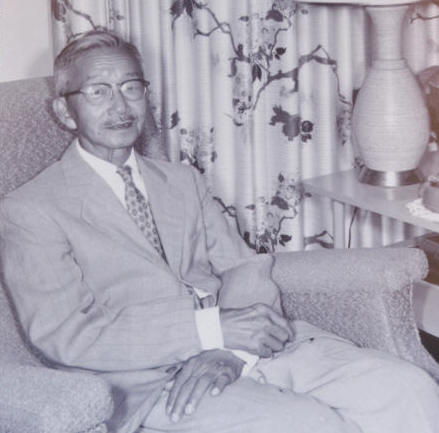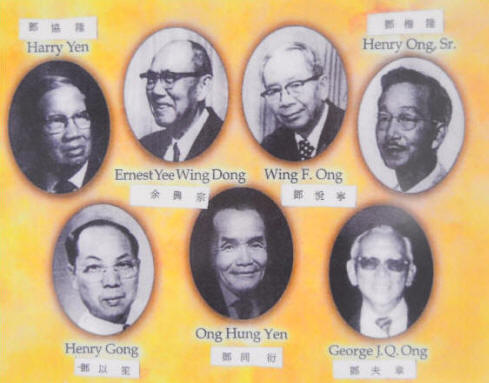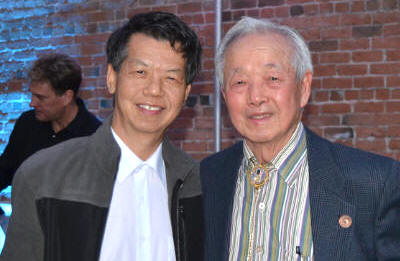|
鳳凰城華人紀念鄧楷隆,是因為他創造了歷史。相信直至目前為止,美國還沒有任何上市公司的辦公大樓中,會放置著一個屬於華人成功的創業之魂,激勵著後人去不懈奮鬥。美國華人在近代歷史上更多的是忍辱負重,但他們自強不息,有所作為和有所貢獻,鄧楷隆前輩就是一個成功的典範,值得我們去景仰和學習。
鄧楷隆的家人紀念他,是因為他是一位奮發圖強、不斷創業的楷模,同時他又是一位好父親和好前輩,讓我們通過鄧楷隆的傳記對這位有歷史貢獻的華人先輩有更詳細的認識。
鄧楷隆 (HENRY ONG ,
Sr.)
,1888年出生在中國廣東省開平市護龍村的永安里。
1907年,三藩市的一位中文報紙主編Yick
Woon Ong,把鄧楷隆作為小兒子申請來到美國,其時他的名字為"ONG
,GAR GEUNG"(鄧家驤),但他只會在有關移民事務使用此名稱,平時他使用的英文名是"HENRY
ONG",直到他成為美國公民時,便正式改用此名。
鄧楷隆初到舊金山,開始學習英語。當初他到中國餐館去打工,但他不喜歡做廚師,於是,便改做食品行業方面的工作。

鄧楷隆
(1888-1960)
1909-1910年,他來到亞利桑那州鳳凰城,在一些親戚中打工,希望攢夠錢後,能開始自己的事業。他於1915年回到中國,在1916年八月和馬麗卿(MAR
LAI HING)小姐結婚,並在1916年十二月返回美國,
1917年1月到達舊金山。之後,夫妻倆回到了鳳凰城,當時他們只有500美元。他用這些錢購買了第三街和東布坎南街(224
E.Buchanan Street
)角落的土地,並建立了一間名為"新和昌"的雜貨店,而住家就建在商店的後面,這在當時是華人"前鋪後居"工作和生活的形式。
1926年,他以17,500美元,在121 E.Buchanan
Street建起了第一家倉庫,到1928年又以16,000美元在117
E.Buchanan Street.建立了第二家倉庫。
鄧楷隆是亞利桑那州首位率先做開發商業地產業務的華人,他把倉庫物業作為出租的用途。因為還沒有成為美國的正式公民,因此不能合法持有產權,該財產便記在他的大兒子鄧粵昂(Robert
Ong)的名下,當年兒子只有8歲大。該物業正式過戶的名稱為“鄧粵昂倉庫”,這是鄧粵昂的粵語名字。
倉庫當時租給了
Smart & Final
公司作批發產品的倉庫使用。後來 Smart & Final
公司把業務擴大到整個亞利桑那州,所租用的倉庫就成為了批發總部,並保持到1950年代中期,直到公司退出批發雜貨業務才停止租賃並出售。"鄧粵昂倉庫"在1985年被列入美國NATIONAL
REGISTER OF HISTORIC PLACES的名單之中,成為鳳凰城中心歷史商業樓宇的一部分。也被列入2000年鳳凰城歷史悠久的文物而被保存下來。2007年,現在的業主R&R
partner公司買下這幢物業,作為鳳凰城分公司新辦公地址。
鄧楷隆有著多方面的貢獻:
•他是首位建立把倉庫物業作為出租用途的華人。
•他是鳳凰城最早擁有私家汽車的華人,當時的汽車是“NASH”。
•他還是亞利桑那州中華商會的八位創會人之一,中華商會成立於1939年,是亞省華人第一個在省政府註冊的組織,鄧楷隆曾擔任中華商會會長。
•鄧楷隆作為華人社區三位領袖之一,要求鳳凰城中央浸信會教堂開設華人主日學,日後成為亞利桑那州鳳凰城第一華人浸信會。
•鄧楷隆在鳳凰城唐人街創辦中文學校,並聘請舊金山的中文老師擔任授課。他擔任中文學校校董,關心華裔下一代成長。
•他是第一個帶領自己的孩子回祖國,接受中華傳統教育的第一人。
•1930年代組織政治活動,支持中國國民政府,他被任命為國民黨的鳳凰分支的領導者,多次成為全美黨部大會代表。
•二次大戰期間,鄧楷隆負責籌組中國救災基金,資助抗戰時的中央國民政府。
•鄧楷隆家庭是鳳凰城唯一的華人"四星級"的家庭,他們的四個兒子在二戰(1942-1946)中當兵保家衛國,各有戰功。
即使沒有受過什麽教育,鄧楷隆先生及太太自學中文和本土文化,當時很少從中國來的女性能像鄧太那樣能讀會寫中文,此外,兩人都精通西班牙語和土著印第安人部落語言。鄧楷隆的好書法是眾所周知的。他的作品在鳳凰城的鄧高密公所可以看到。
作為第一代的華人移民,鄧楷隆一生目光遠大,他勤奮好學讓他練就生意頭腦,他不懈工作使到他邁向成功,而成功後的鄧楷隆不忘回饋社會,不忘回饋華人社區。他在華人社群中是一位僑領,他在家中是一位慈父,他的言傳身教直到他生命的最後一刻:
他教導孩子,在他的葬禮上取消封建的傳統習俗,比如燒香,擺設熟雞和燒冥錢等,只需虔誠跪拜,放置花圈在他的骨灰盒上。他的開闊心胸令人景仰,至今,許多鳳凰城華人的葬禮都采用了這種形式。
鄧楷隆夫婦是七個孩子父母:孩子分別是: Sophie,
Robert, Fred, Henry Jr., Frank, Joseph
and Lily。他們還有21個孫子,如今的第三代和第四代的後代生活在全美各地,以及歐洲和亞洲。

BIOGRAPHY OF HENRY ONG,
SR.
(1888-1960 )
Article
by Henry
Ong
Henry Ong, Sr., (鄧
楷
隆)
was born in the village
of Hu Long (
護
龍)
Wing On Lae (永安理)
Kaiping City, province
of GUANGDONG, CHINA.
He came to the United
States as a minor son of
a Chinese teacher,
became lawfully
domiciled and a legal
resident of the United
States in 1907 under the
name ONG GAR GEUNG (鄧
家
壤).
He would use this name
only on matters relating
to immigration. He
continued to use the
name HENRY ONG in
business dealings until
he became a United
States citizen and
officially changed his
name to HENRY ONG, Sr.
Upon arriving in San
Francisco in 1907, he
learned the English
language and worked
first as chef in various
Chinese restaurants. He
did not like it and made
a change to work in the
grocery business
instead.
He came to Phoenix when
Arizona was still a
Territory around
1909-1910 and worked for
some relatives, saving
enough to eventually
start his own business.
He returned to China in
1915, and married MAR
LAI HING (馬
麗
卿)
in August of 1916 and
returned to the U.S. in
December of 1916,
arriving in San
Francisco in January of
1917.
The couple returned to
Phoenix. With $500.00
in hand, he purchased
land on the SW corner
of 3rd St.
and East Buchanan
Street (224 E. Buchanan
St.) and built his
grocery store (Sun Wah
Cheang) with residential
quarters in the back of
the store.
He built the first
warehouse at 121 East
Buchanan Street in 1926
at a cost of $17,500,
then built a second
warehouse at 117 East
Buchanan Street in 1928
for $16,000.
Henry Ong Sr. was the
first Arizona Chinese
native to develop
commercial property,
built specifically for
rental purposes. As he
was not yet a formal
citizen of the United
States and thus could
not legally hold title
to property, the title
of the property was held
in the name of his
oldest son Robert, who
was only 8 years old at
the time. The property
was formally deeded as
“Ong Yut Geong(鄧
粵
昂)
Warehouse” which was
Robert’s Cantonese name.
The warehouse was leased
to others to use as a
wholesale produce
warehouse. When Smart &
Final Wholesale Grocery
Company expanded their
operations to Arizona,
they leased the
warehouse as their
Arizona headquarters and
stayed until the
mid-1950’s when they
pulled out of the
wholesale grocery
business.
The “Ong Yut Geong”
warehouse was listed on
the NATIONAL REGISTER OF
HISTORIC PLACES in 1985
as part of the Historic
Commercial Properties in
Central Phoenix. These
multiple properties help
document the evolution
of commercial activity
in downtown Phoenix
circa 1880 to 1947. The
property was also listed
on the PHOENIX HISTORIC
PROPERTY REGISTER in
2000.
Contributions and
legacies by Henry Ong,
Sr.
·
First Chinese American
to build and develop
commercial property for
rental purposes
·
First native Chinese
Phoenician to own and
operate an automobile
·
One of eight Chinese
leaders to organize and
found the Chinese
Chamber of Commerce of
Arizona
·
One of three Chinese
community leaders to
request the CENTRAL
BAPTIST CHURCH OF
PHOENIX to start a
Chinese Sunday School
under the auspices of
the Southern Baptist
Convention, which later
became a church plant
and was constituted as
the FIRST CHINESE
BAPTIST CHURCH of
Phoenix, Arizona
·
Organized a Chinese
language school, with
class rooms in Phoenix
Chinatown, hiring
Chinese teachers from
San Francisco
·
Became the first person
to bring his family back
to China for his
children’s education
·
Appointed as leader of
the Phoenix branch of
Kuomintang (KMT), a
political activist group
in support of the
Chinese Nationalist
government circa 1930’s.
·
Was in charge of the
Chinese Relief Funds to
help the Nationalist
Chinese government
during WW2.
·
Phoenix’s only Chinese
Four Star Family,
that is four sons of Mr.
& Mrs. Henry Ong, Sr.,
ALL SERVED THEIR COUNTRY
IN WW2 (1942-1946):
Robert, Fred, Henry Jr.
and Frank
His final community
influence:
Instructions to his
children that at the
grave side of his
funeral, to abolish the
old traditions of elder
worship, such as the
burning of incense,
cooked chicken, and
paper monies etc., only
to bow reverently in
front of the casket and
place a flower stem on
top of his casket.
Many local Chinese
funerals today in
Phoenix have adopted
this form of funeral
service.
Even with little
education, Mr. & Mrs.
Ong were self –taught in
the Chinese language.
Very few Chinese women
from China at that time
could read and write
Chinese. In addition,
both were fluent in
Spanish and native
Indian tribal languages.
Henry Ong’s calligraphy
was well known to people
who knew him. His
writings can be seen at
the ONG KO MET
headquarters in Phoenix
(2602 N. 16th
Street).
Henry and Mar Lai Hing
Ong were parents to
seven children: Sophie,
Robert, Fred, Henry Jr.,
Frank, Joseph and Lily.
They were also
grandparents to 21
grandchildren and today
have various 3rd
and 4th
generation offspring
living in various parts
of the country, as well
as Europe and Asia.

Henry Ong (R) and
homer Zhang
|